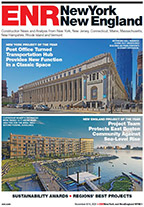But some Portsmouth community members argue that the bridge needs more architectural finesse to replicate the design of the original historic bridge. Lisa DeStephano, architect in Portsmouth has suggested adding cables to the design to echo the visual character of the old bridge design.
Zoli says he is not a fan of embellishments on structural systems, especially when building public works projects with taxpayer money. “I am sensitive to honoring the work of Waddell by approaching the mechanical and structural system as a work of innovation,” he says.
For instance, all of the bridge operating equipment was housed in the bridge span of the original structure. In the new design, machinery is tucked under both ends of the span near where the bridge lifts. “This will eliminate the “Chitty-Chitty-Bang-Bang gear system and provide more direct control,” Zoli says.





